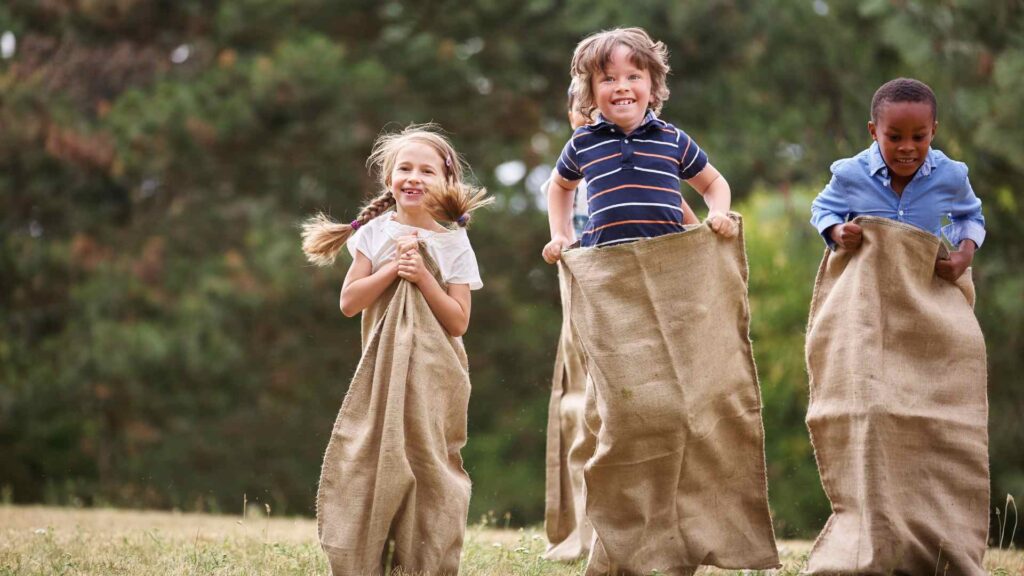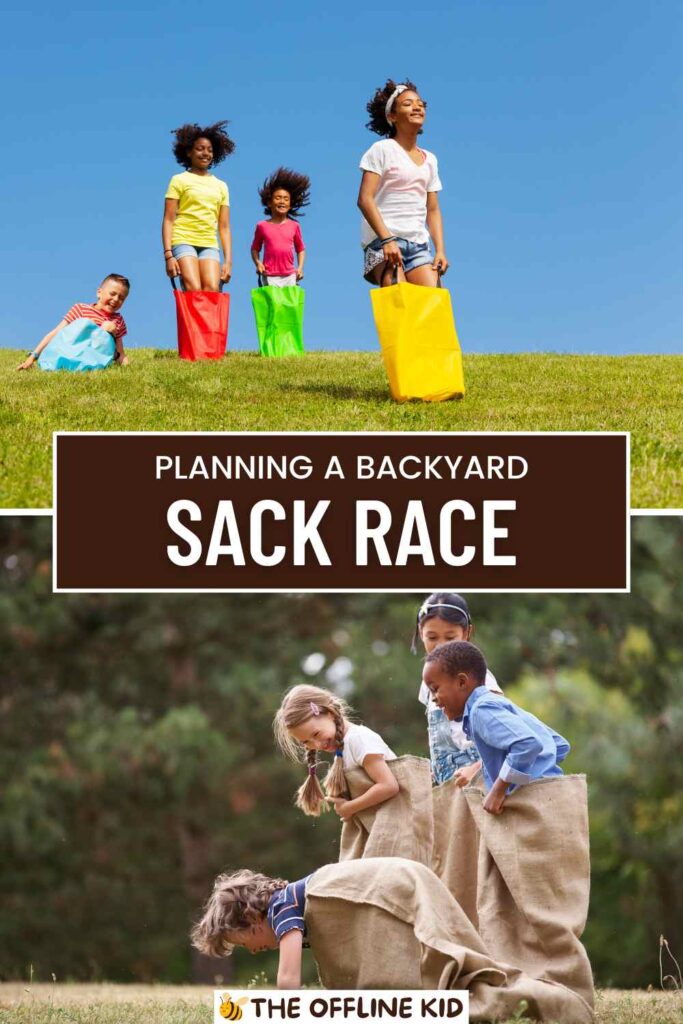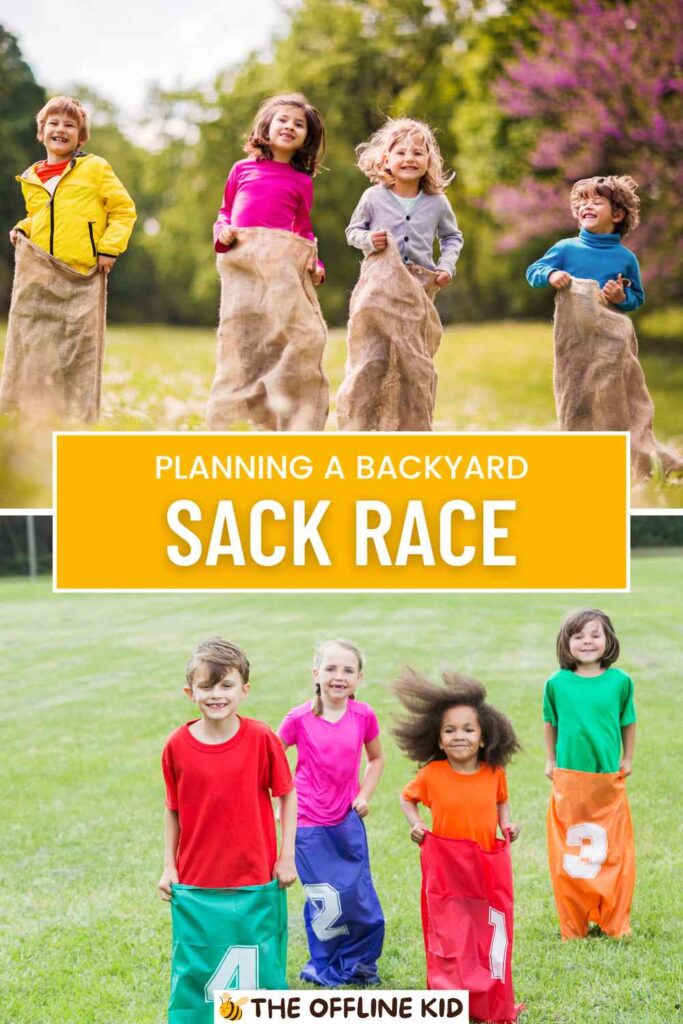Discover how to plan the perfect backyard sack race with our comprehensive guide.
From preparation to execution, we’ve got you covered to ensure a fun-filled, memorable event for all ages.
Preparing for the Event
Choosing the Right Location
Size and Terrain Considerations
- Space: Ensure you have enough space for the race. A typical sack race requires at least 30 feet of flat ground.
- Terrain: Choose a grassy area to provide a softer landing. Avoid rocky or uneven terrain to prevent injuries.
Safety First: Avoiding Hazards
- Check for Obstacles: Clear the area of any rocks, sticks, or other obstacles that could cause tripping or injury.
- Boundaries: Use cones or markers to outline the race area and keep participants within safe limits.
Indoor Alternatives for Rainy Days
- Indoor Spaces: A large basement, gymnasium, or community center can serve as an indoor alternative.
- Surface: Ensure the indoor surface is non-slippery and safe for running.
Gathering Supplies
Selecting the Perfect Sacks
- Material: Burlap sacks are traditional, but you can also use sturdy fabric sacks.
- Size Options: Ensure sacks are large enough for participants to fit comfortably. Adult-sized sacks for older kids and adults, and smaller sacks for younger children.
Optional Equipment
- Cones and Markers: Use cones to mark start and finish lines and to create a race course.
- Whistles: For starting the race and signaling the end.
- Start/Finish Line Tape: Clearly mark the beginning and end of the race.
Decorating the Race Area
- Banners and Flags: Add a festive touch with colorful banners and flags.
- Themed Decor: Match decorations to the theme of your event for added fun.
Setting a Date and Time
Ideal Times for Outdoor Fun
- Morning or Late Afternoon: These times are usually cooler and more comfortable for outdoor activities.
- Weekend Days: Ensure more people can attend by scheduling the event on a weekend.
Considering Weather and Season
- Seasonal Considerations: Spring and fall are ideal for outdoor events. Avoid the extreme heat of summer or the chill of winter.
- Weather Forecast: Keep an eye on the forecast and have a backup plan for inclement weather.
Sending Out Invitations
- Advance Notice: Send invitations at least two weeks in advance.
- Details: Include the date, time, location, and any special instructions (like bringing their own sack if needed).
- RSVP: Request RSVPs to get an idea of how many participants to expect.

Planning the Race
Setting Up the Course
Measuring and Marking the Race Distance
- Standard Distance: A typical backyard sack race course is about 30-50 feet long.
- Markers: Use cones or chalk to mark the starting and finishing lines.
Start and Finish Line Setup
- Visual Cues: Use brightly colored tape or banners to clearly indicate the start and finish lines.
- Ensure Safety: Make sure there is ample space beyond the finish line for participants to stop safely.
Optional Obstacles and Variations
- Obstacle Course: Add fun challenges like small hurdles or weaving between cones.
- Team Relays: Organize teams and set up relay points for a team sack race.
Rules and Guidelines
Basic Sack Race Rules
- Start Position: Participants start with both feet in the sack, holding the top edges.
- Racing: On the whistle, participants hop towards the finish line. The first to cross wins.
- No Running: Participants must hop, not run.
Creating Fair Teams
- Age and Size Groups: Group participants by age and size to ensure fair competition.
- Mixed Teams: For a fun twist, mix different ages and sizes within teams for relay races.
Safety Guidelines
- Proper Warm-Up: Encourage participants to stretch and warm up before the race.
- Monitor Conditions: Keep an eye on weather conditions and adjust plans if necessary.
Creating a Schedule
Pre-Race Activities and Warm-Ups
- Games: Organize simple games to keep participants engaged before the race starts.
- Stretching: Lead a group warm-up session to prevent injuries.
Organizing Heats and Finals
- Heats: If you have many participants, organize heats with winners advancing to finals.
- Finals: Conduct a final race with winners from each heat to determine the overall champion.
Post-Race Celebrations
- Award Ceremony: Plan a small award ceremony to celebrate winners and participants.
- Refreshments: Offer snacks and drinks to refresh everyone after the race.
With these preparations in place, you’re well on your way to hosting a fantastic backyard sack race that will be enjoyable and memorable for all your participants.

Engaging Participants
Promoting the Event
Fun Invitations and Announcements
- Creative Invitations: Design invites that reflect the playful spirit of the sack race.
- Include Details: Mention date, time, location, and any special themes or instructions.
Social Media and Community Boards
- Create an Event Page: Use platforms like Facebook to reach a wider audience.
- Community Engagement: Post on local community boards or newsletters to attract neighbors and friends.
Engaging Descriptions and Teasers
- Highlight Benefits: Emphasize the fun, fitness, and social aspects of participating.
- Tease Special Features: Mention any unique aspects, like themed costumes or post-race activities.
Pre-Race Activities
Warm-Up Games and Exercises
- Fun Warm-Ups: Incorporate games like relay races or jumping jacks to get participants excited.
- Stretching: Guide everyone through stretches to prevent injuries and improve flexibility.
Sack Race Practice Runs
- Trial Runs: Allow participants to practice hopping in sacks to get comfortable.
- Mock Races: Hold informal races to build anticipation and confidence.
Fun and Educational Activities Related to the Event
- History Lesson: Share the origins of sack races or other fun facts related to the event.
- Craft Station: Set up a station for decorating or customizing sacks before the race.
Inclusive Participation
Adapting for Different Age Groups
- Age Categories: Consider separate races or rules for different age groups (e.g., kids, teens, adults).
- Modified Rules: Adjust rules slightly for younger or older participants to ensure fairness.
Encouraging Participation from All Abilities
- Accessibility: Ensure the race course and activities are accessible to everyone.
- Adaptive Equipment: Provide options like larger sacks or assistance for those with mobility challenges.
Creating a Supportive and Fun Environment
- Team Spirit: Encourage cheering and support among participants and spectators.
- Positive Reinforcement: Celebrate efforts and improvements, not just winners.
By actively engaging participants before the race and creating an inclusive environment, you’ll enhance the overall experience and ensure everyone has a blast at your backyard sack race event.

Running the Event
Event Day Preparations
Final Checks and Setup
- Course Inspection: Ensure the race course is clear and properly marked.
- Equipment Check: Verify all equipment (sacks, cones, whistles) is in place and functional.
- Volunteer Briefing: Gather volunteers and brief them on their roles and responsibilities.
Setting Up a Registration Table
- Check-In Process: Have a streamlined check-in process for participants.
- Distribute Sacks: Provide participants with their designated sacks if not already distributed.
Conducting the Race
Managing the Crowd
- Crowd Control: Designate areas for spectators and ensure they do not interfere with the race.
- Announcing Heats and Racers: Use a megaphone or loudspeaker to announce heats and participants.
Starting the Race with Excitement
- Whistle Start: Use a whistle or loud signal to start each heat of the race.
- Fair Starts: Ensure all participants start from a fair position and understand the rules.
Awarding Prizes
Fun and Creative Prizes
- Categories: Consider awards for first, second, and third place in each age group.
- Participation Awards: Recognize all participants with certificates or small tokens of appreciation.
Recognizing Participation and Effort
- Encouragement: Applaud participants’ efforts and highlight memorable moments.
- Speech or Thank-You: Thank volunteers and participants for making the event a success.
Holding an Award Ceremony
- Location: Choose a central location where everyone can gather.
- Presentation: Hand out awards or certificates and take photos to commemorate the occasion.
With these steps, you can smoothly run your backyard sack race event, ensuring participants have a great time and leave with fond memories of their racing experience.
Post-Event Activities
Cool Down and Refreshments
Providing Drinks and Snacks
- Hydration: Offer water and juices to keep participants refreshed.
- Healthy Snacks: Provide snacks like fruit, granola bars, or sandwiches for energy replenishment.
Post-Race Cool Down Exercises
- Gentle Stretching: Lead participants through cool-down stretches to prevent muscle soreness.
- Relaxation: Encourage relaxation techniques like deep breathing or light massage.
Cleanup and Teardown
Efficient Cleanup Strategies
- Assign Tasks: Delegate volunteers to different cleanup areas for efficiency.
- Dispose of Waste: Collect and properly dispose of any trash or recyclables.
Thanking Volunteers and Participants
- Acknowledgement: Publicly thank volunteers for their time and effort.
- Participant Feedback: Encourage participants to share their thoughts and experiences.
Sharing Memories
Taking Photos and Videos
- Capture Moments: Document the event with photos and videos of races and award ceremonies.
- Create a Memory Book or Video
- Compilation: Compile photos and videos into a digital or physical keepsake.
- Add Captions: Include captions or quotes from participants for a personal touch.
Sharing on Social Media
- Highlights: Share event highlights on social media platforms.
- Community Engagement: Tag participants and encourage them to share their own photos and memories.
By organizing engaging post-event activities and documenting the experience, you’ll ensure that your backyard sack race leaves a lasting impression on everyone involved, fostering a sense of community and fun memories for years to come.

Tips and Tricks for a Successful Sack Race
Common Pitfalls and How to Avoid Them
Safety Concerns
- Inspect the Area: Before the event, thoroughly inspect the race area for any potential hazards such as rocks, holes, or uneven terrain.
- Clear Instructions: Clearly communicate safety rules to participants and spectators to prevent accidents.
Managing Different Age Groups
- Age Categories: Consider dividing participants into age-appropriate groups to ensure fair competition and safety.
- Adjust Rules: Modify rules slightly for younger children or older adults to accommodate their abilities.
Handling Unexpected Weather
- Backup Plan: Have a backup indoor location or alternative date in case of inclement weather.
- Weather Updates: Monitor weather forecasts leading up to the event and inform participants of any changes.
Enhancing the Experience
Adding Themes and Costumes
- Theme Ideas: Incorporate fun themes like sports, superheroes, or seasonal motifs to add excitement.
- Costume Contest: Host a costume contest alongside the race for added fun and creativity.
Incorporating Music and Entertainment
- Playlists: Create a lively playlist of music to energize participants and spectators throughout the event.
- Entertainment Activities: Consider adding activities like face painting, balloon animals, or live performances to keep everyone engaged.
Creating a Festival Atmosphere
- Decorations: Use colorful banners, balloons, and signage to create a festive ambiance at the race venue.
- Food and Refreshments: Offer a variety of food options such as popcorn, cotton candy, and lemonade to enhance the carnival-like atmosphere.
Feedback and Improvement
Gathering Participant Feedback
- Surveys: Distribute simple surveys to participants and volunteers to gather feedback on their experience.
- Open Communication: Encourage participants to share suggestions and ideas for improving future events.
Reflecting on What Worked Well
- Successes: Identify aspects of the event that were particularly successful or well-received by participants.
- Learning Opportunities: Use feedback to pinpoint areas for improvement and growth in future sack race events.
Planning for Future Events
- Yearly Tradition: Consider making the backyard sack race an annual or seasonal tradition that participants can look forward to.
- Expand and Innovate: Continuously brainstorm new ideas and innovations to keep the event fresh and exciting each year.
By implementing these tips and tricks, you can elevate your backyard sack race from a simple event to a memorable and enjoyable experience for everyone involved, ensuring each race day is better than the last.
Conclusion
Hosting a backyard sack race is not just about hopping in sacks; it’s about creating lasting memories and fostering community spirit.
By following the steps outlined in this guide, you’ve learned how to plan, organize, and execute a successful event that delights participants of all ages.
Remember, the key ingredients are safety, fun, and inclusive participation. Whether it’s your first time hosting or you’re a seasoned event planner, the joy and laughter shared during a sack race will resonate long after the event ends.
Reflect on the feedback received, celebrate the successes, and use the lessons learned to enhance future events.
With careful planning and creativity, your backyard sack race can become a cherished tradition that brings friends, family, and neighbors together year after year.
So, gather your sacks, mark your course, and get ready for a day filled with laughter, friendly competition, and unforgettable moments. Happy racing!


